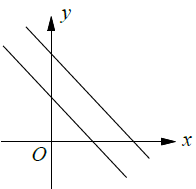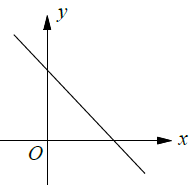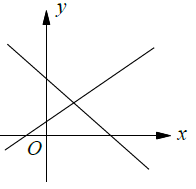DETERMINE THE NUMBER OF SOLUTIONS TO A SYSTEM OF EQUATIONS
Subscribe to our ▶️ YouTube channel 🔴 for the latest videos, updates, and tips.
A set of equations with two variables is called system of linear equations.
A system of linear equations can have
(i) No solution (Parallel lines)
(ii) Infinitely many solutions (Coinciding lines)
(iii) Unique solution (Intersecting lines)
What is solution ?
The point of intersection is known as solution.
No solution |
Infinitely Many |
Intersecting lines |
Parallel will have same slope and different y-intercepts Coinciding lines will have same slope and same y intercept. Intersecting lines will at one point. |
Problem 1 :
x - 3y = 4
2(x - 1) - 6(y + 2) = -6
How many solutions (x, y) are there to the system of equations above ?
(a) zero (b) One (c) Two (d) More than two
Solution :
x - 3y = 4 -----(1)
2(x - 1) - 6(y + 2) = -6 -----(2)
From (2)
2x - 2 - 6y - 12 = -6
2x - 6y = -6 + 12 + 2
2x - 6y = 8
Dividing by 2, we get
x - 3y = 4
Since both are same lines, they will be coinciding lines and it has infinitely many solutions.
Problem 2 :
ax + 4y = 14
5x + 7y = 8
In the system of equations above, a is constant and x and y are variables, If the system has no solution, what is the value of a ?
(a) 20/7 (b) 35/4 (c) -35/4 (d) -20/7
Solution :
ax + 4y = 14
5x + 7y = 18
Since it has no solution, they are parallel lines. So,
m1 = m2
|
ax + 4y = 14 4y = -ax + 14 y = (-a/4) x + (14/4) m1 = -a/4 ----(1) |
5x + 7y = 18 7y = -5x + 18 y = (-5/7)x + 18/7 m2 = -5/7----(2) |
(1) = (2)
-a/4 = -5/7
a = 20/7
Problem 3 :
ax + (1/2)y = 16
4x + 3y = 8
In the system of equations above, a is constant. If the system has no solution, what is the value of a ?
Solution :
ax + (1/2)y = 16
4x + 3y = 8
It has no solutions, they must be parallel and they will have same slopes.
|
ax + (1/2)y = 16 y/2 = -ax + 16 y = -2ax + 32 m1 = -2a |
4x + 3y = 8 3y = -4x + 8 y = (-4/3)x + 8/3 m2 = -4/3 |
(1) = (2)
-2a = -4/3
a = 2/3
Problem 4 :
Paper West has produced 5000 kg of napkins. It continues to manufacture 350 kg of napkins per week. Northern Paper manufactures napkins at a rate of 1400 kg per month and has already produced 28000 kg. Assume one month has exactly four weeks.
a) Write a system of linear equations to represent the manufacturing of the napkins.
b) Explain how the number of solutions to the system relates to this situation.
Solution :
Let x be the number of weeks and y be the quantity of napkins produced.
a)
Paper west manufactures :
y = 5000 + 350x
Northern paper manufactures :
= 1400/ 4
= 350 kg per week
y = 28000 + 350x
b) The system will have unique solution. When the companies manufacturing in the same rate, at which month both companies will produce the same number of napkins.
Problem 5 :
For the linear system 2x + 3y = 12 and 4x + 6y = C, what value(s) of C will give the system
a) an infinite number of solutions?
b) no solution?
Solution :
2x + 3y = 12 ----(1)
4x + 6y = C ------(2)
From (1), 3y = -2x + 12
y = (-2/3)x + 12/3
y = (-2/3)x + 4
From (2), 6y = -4x + C
y = (-4x/6) + C/6
y = (-2x/3) + C/6
a) When the system of linear equations has infinite number of solutions, then
m1/m2 = c1/c2
-2/3 / (-2/3) = 4/(C/6)
1 = 24/C
C = 24
b) No solution
m1/m2 ≠ c1/c2
-2/3 / (-2/3) ≠ 4/(C/6)
1 ≠ 24/C
C ≠ 24
Problem 6 :
Without graphing, decide whether the system of equations has one solution, no solution, or infinitely many solutions.
y = 3x + 14
y = –3x + 14
Solution :
y = 3x + 14
Slope = 3 and y-intercept = 14
y = -3x + 14
Slope = -3 and y-intercept = 14
By observing the above, the slopes are not equal. So, the system has unique solution.
Problem 7 :
Without graphing the equations, decide whether the system has one solution, no solution, or infinitely many solutions.
5y = x – 9
4x – 10y = 18
Solution :
Finding slope and y-intercept of these two lines :
From (1), 5y = x – 9
y = (1/5) x - (9/5)
4x – 10y = 18
10y = 4x - 18
y = 4x/10 - (18/10)
y = 2x/5 - 9/5
From (2), 4x – 10y = 18
10y = 4x - 18
y = 4x/10 - (18/10)
y = 2x/5 - 9/5
By observing slope and y-intercepts, slopes are equal and y-intercepts are also equal. Then the system has infinite number of solutions.
Subscribe to our ▶️ YouTube channel 🔴 for the latest videos, updates, and tips.
Recent Articles
-
Finding Range of Values Inequality Problems
May 21, 24 08:51 PM
Finding Range of Values Inequality Problems -
Solving Two Step Inequality Word Problems
May 21, 24 08:51 AM
Solving Two Step Inequality Word Problems -
Exponential Function Context and Data Modeling
May 20, 24 10:45 PM
Exponential Function Context and Data Modeling